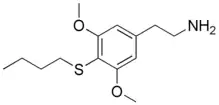Thiobuscaline
 | |
| Names | |
|---|---|
| Preferred IUPAC name
2-[4-(Butylsulfanyl)-3,5-dimethoxyphenyl]ethan-1-amine | |
| Identifiers | |
CAS Number |
|
3D model (JSmol) |
|
| ChEMBL | |
| ChemSpider | |
PubChem CID |
|
CompTox Dashboard (EPA) |
|
InChI
| |
SMILES
| |
| Properties | |
Chemical formula |
C14H23NO2S |
| Molar mass | 269.403 g/mol |
Except where otherwise noted, data are given for materials in their standard state (at 25 °C [77 °F], 100 kPa). | |
| Infobox references | |
Thiobuscaline, or 3,5-dimethoxy-4-butylthiophenethylamine, is a lesser-known psychedelic drug.
History
It is an analog of buscaline. Thiobuscaline was first synthesized by Alexander Shulgin. In his book PiHKAL (Phenethylamines i Have Known And Loved), the dosage range is listed as 60–120 mg, and the duration is listed as 8 hours. Thiobuscaline is an entheogen, and it causes a threshold. Very little data exists about the pharmacological properties, metabolism, and toxicity of thiobuscaline.
See also
External links
This article is issued from Offline. The text is licensed under Creative Commons - Attribution - Sharealike. Additional terms may apply for the media files.